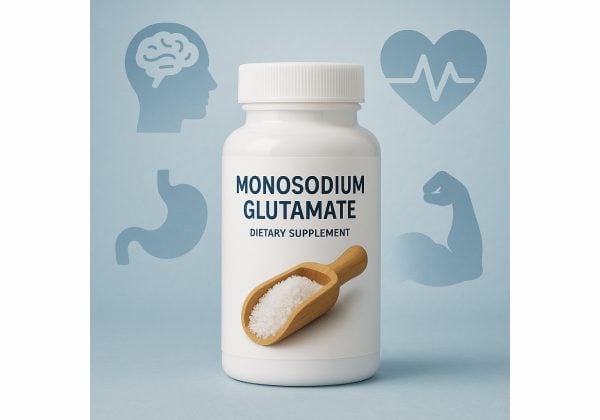
Monosodium glutamate (MSG) is the purest, most convenient source of umami, the savory taste our palates instinctively recognize in slow-simmered broths, aged cheeses, tomatoes, mushrooms, and cured meats. In the kitchen, MSG is not a magic trick—it is a precision seasoning: a tiny amount boosts depth, rounds bitterness, and lets you cut salt without sacrificing satisfaction. In the body, MSG separates into sodium and glutamate; glutamate is a common amino acid present in many proteins and produced by our cells. Modern evidence supports MSG’s safety at typical culinary amounts, while debunking the idea that it causes consistent adverse reactions when used with food. The most reliable benefits are better flavor with less sodium, improved acceptance of low-salt dishes, and a cleaner way to enhance soups, sauces, and plant-forward meals. This guide clarifies how MSG works, how to use it effectively, how much to add, who should be cautious, and what the best research shows—so you can season with skill and confidence.
Quick Facts
- Enhances savory depth and lets many recipes cut sodium by ~10–30% without losing taste.
- Typical kitchen use: about 0.1–0.8% of a dish’s weight or roughly 0.25–0.5 g per serving.
- Safety: generally recognized as safe at culinary amounts; large bolus doses (>3 g) without food may trigger transient symptoms in a few sensitive people.
- Avoid or consult a clinician if you report reproducible reactions to high-dose MSG, are managing complex migraine triggers, or are preparing food for infants.
Table of Contents
- What is monosodium glutamate?
- Benefits and how it works
- How to use MSG in cooking
- How much MSG per meal?
- Safety, side effects, and who should avoid
- Evidence summary and key numbers
What is monosodium glutamate?
MSG in one sentence: MSG is the sodium salt of L-glutamic acid, a ubiquitous amino acid; in food it functions as a taste-active compound that delivers umami.
Where it comes from. Today’s MSG is made by fermentation (much like yogurt or vinegar). Microbes convert carbohydrate sources (e.g., sugarcane or beets) into glutamic acid, which is then neutralized with sodium and crystallized. The result is a white, free-flowing powder that dissolves readily in water and integrates quickly in hot or cold foods.
How your body handles it. After eating, MSG dissociates into glutamate and sodium. Your intestines and liver metabolize glutamate efficiently because it is both a building block and a fuel in the gut. The added glutamate from normal seasoning amounts is small compared with what you naturally consume from protein foods and what your own cells produce. Sodium from MSG is significantly lower per gram than from table salt because MSG is only about one-third as sodium-dense as sodium chloride.
Taste biology in brief. Your tongue detects umami through T1R1/T1R3 and mGluR receptors. When a dish contains free glutamate (from MSG or from foods like tomatoes, parmesan, kombu, or aged ham), these receptors fire and the brain reads a fuller, savory taste. This amplifies salience: salt tastes saltier, bitter edges soften, and aromas seem more vivid.
What MSG is not. It is not gluten, not a preservative, and not the same as “hydrolyzed” or “autolyzed” ingredients (those are complex flavor sources that contain glutamates). MSG is a single, well-defined molecule—useful for precise, repeatable seasoning.
Labels and names. In packaged foods, MSG appears as “monosodium glutamate.” Foods naturally rich in glutamate (tomatoes, mushrooms, parmesan) are not “MSG,” but they deliver the same taste-active glutamate your receptors perceive.
Bottom line. MSG is a tool: it gives cooks a controlled way to boost savory flavor and reduce sodium. The key is dosing thoughtfully and pairing it with good culinary technique.
Benefits and how it works
1) Bigger flavor at lower sodium. The most practical value of MSG is salt reduction without disappointment. In both controlled tasting panels and real-food modeling, partially swapping salt with MSG can maintain or even improve liking while dropping sodium meaningfully. The effect size depends on the food, but about 10–30% less sodium is a reasonable, repeatable target in soups, sauces, pan juices, dressings, rice dishes, and many vegetable preparations. With good recipe engineering, some products achieve larger cuts.
2) Better acceptance of plant-forward and low-salt dishes. Vegetables, legumes, whole grains, and lean proteins often taste flat when sodium goes down. Umami solves this by increasing taste intensity and masking bitterness. If you are shifting your household toward lower-sodium cooking, MSG lets you keep the pleasure signal intact—critical for long-term adherence.
3) Cleaner flavor design. Because MSG is single-note umami, you can tune a dish precisely. Want the depth of parmesan or aged ham without adding dairy or cured meat? A pinch of MSG plus acids (e.g., lemon juice), aromatics, and heat-driven browning produces similar perceived richness with fewer calories, less saturated fat, and—if desired—less sodium.
4) Consistency in batch cooking. MSG integrates quickly and is heat stable at typical cooking temperatures. That makes it reliable for large-format soups, braises, stews, and meal prep where every ladle should taste the same. It is especially helpful in low-sodium institutional cooking, where salt ceilings are strict but diners still expect comfort and fullness.
5) Taste synergy with glutamate-rich foods. MSG plays well with ingredients already high in free glutamate (ripe tomatoes, mushrooms, seaweed, anchovies, soy sauce, parmesan). Together they create layered umami, so you can season lightly yet get a long, satisfying finish.
6) What it does not do. It does not add meatiness when a dish lacks Maillard flavors, nor does it cover up poor technique. Dishes still need proper browning, acidity, and texture. And MSG does not “fix” sweetness, sourness, or heat by itself; it supports the overall balance.
Practical examples.
- Tomato soup: Reduce salt by 20%, add 0.3% MSG by weight; brightness with a teaspoon of sherry vinegar at the end.
- Sautéed mushrooms: Salt lightly, then finish with a pinch of MSG and butter; the savory roundness increases and bitterness recedes.
- Brown rice: Add a small pinch to the cooking water; grains taste fuller without extra butter or stock.
- Vegetable stir-fry: A late splash of soy sauce plus a dusting of MSG elevates greens without oversalting.
Sustainability angle. If you cook more vegetables and whole grains because they taste great at lower sodium, you are aligning flavor with long-term health and environmental goals.
How to use MSG in cooking
Use MSG like a scalpel, not a hammer. The goal is to enhance, not to taste “MSG.” Think of it as the zoom knob for savoriness—small adjustments until the dish comes into focus.
Where it shines
- Watery, lean, or low-salt bases: clear soups, vegetable broths, poaching liquids.
- Plant-forward and grain dishes: roasted vegetables, beans, lentils, pilafs.
- Simple proteins: pan sauces for chicken breast, pork tenderloin, tofu.
- Cold applications: vinaigrettes, tomato salads, tuna or bean salads.
- Snacks and rubs: popcorn, roasted nuts, dry rubs (paired with spices).
Pairing rules
- Salt first, then MSG to finish. Build foundational salinity with salt (or salty ingredients), then taste and fine-tune umami with a pinch of MSG near the end.
- Stack with natural umami. Use tomatoes, mushroom powder, soy sauce, miso, parmesan, anchovy, or nutritional yeast alongside MSG for complex depth.
- Balance with acid and aroma. Lemon juice, vinegar, wine reductions, garlic, shallot, charred alliums, and herbs frame umami so it reads as clean, not muddy.
- Mind bitterness. MSG can soften bitterness but cannot fix excessive char or heavy tannins; balance with a touch of sweetness or extra acid.
- Watch hidden sodium. If you are using salty components (soy sauce, fish sauce), you may need less salt and less MSG to hit the same pleasure point.
How to add
- Pinch and stir. For stovetop dishes, sprinkle a small pinch, stir, and re-taste after 20–30 seconds.
- Bloom in liquid. For soups and sauces, whisk MSG into a spoonful of hot liquid to dissolve fully, then incorporate.
- Pre-mix with salt. A simple seasoning blend (for example, 2 parts kosher salt : 1 part MSG) is an easy way to lower sodium while seasoning intuitively.
- Dry rubs. Combine MSG with spices for meats or tofu; it survives roasting and grilling well.
Culinary guardrails
- Less is more. If a dish tastes “artificial” or oddly flat, you used too much or skipped acid/aromatics. Pull back and rebalance.
- No need everywhere. Rich stocks, aged cheeses, cured meats, or slow braises may already be umami-saturated; add only if it meaningfully improves flavor at lower salt.
- Storage. Keep MSG dry and tightly sealed. It clumps with moisture.
Simple starting ideas
- Tomato salad: Salt the tomatoes, then dust a tiny pinch of MSG right before serving.
- Chicken noodle soup: Replace 25% of the salt with MSG; finish with lemon.
- Popcorn: Toss with olive oil, a light shower of MSG, paprika, and black pepper.
- Roasted broccoli: After roasting, toss with MSG, lemon zest, and grated parmesan.
How much MSG per meal?
Two reliable ways to dose
- By dish weight: MSG at ~0.1–0.8% of the finished weight works for most savory foods. For a 500 g pot of soup, that is 0.5–4 g total. Start low; most home dishes land near 0.2–0.5% (1–2.5 g per 500 g).
- By serving: For routine home cooking, ~0.25–0.5 g per serving (about a small pinch) typically enhances flavor without calling attention to itself.
Kitchen heuristics
- Soups and stews: 1/4 teaspoon per 2 cups (480 ml), then adjust.
- Stir-fries: a small pinch per skillet batch just before plating.
- Ground meats or plant crumbles: 1/8–1/4 teaspoon per lb (450 g) in the mix.
- Seasoning salt blend: mix 2 parts salt with 1 part MSG; use as you would regular salt, then adjust to taste.
Sodium math made simple
- Gram for gram, MSG delivers about one-third the sodium of table salt. Replacing a portion of salt with MSG can therefore lower sodium while preserving salty satisfaction—especially in soups, sauces, dressings, snacks, and breads.
Timing and absorption
- Add a touch early to season the base, then finish with a tiny top-up to dial in the final savoriness. MSG dissolves quickly and integrates evenly; you rarely need to “cook it in” for long.
When to hold back
- If your dish already contains parmesan, cured meats, miso, anchovy, soy sauce, or mushroom concentrate, start with half your usual MSG and salt plan.
- If you are preparing food for infants, do not add MSG (or excess salt) to their portions; infants’ diets should be managed under pediatric guidance.
Taste test protocol (fast)
- Season with salt until a dish tastes almost right.
- Add a pinch of MSG, stir, and taste again.
- If the dish suddenly seems more cohesive—saltier without extra salinity, rounder, and longer on the palate—you are at the sweet spot. If it tastes “hollow,” add acid or aroma, not more MSG.
Upper bounds
- Large single bolus doses (for example >3 g all at once without food) are unnecessary in cooking and more likely to cause discomfort in susceptible people. In real recipes, per-portion amounts are usually well under 0.5 g.
Safety, side effects, and who should avoid
Regulatory perspective. Major authorities classify MSG as safe at typical dietary intakes. It has long been permitted as a flavor enhancer; scientific re-evaluations have set conservative safe intake benchmarks for glutamates used as food additives, and food safety agencies continue to confirm its general safety when used as intended.
Common experiences at kitchen doses
- Well tolerated by the vast majority of people when consumed with food.
- No special preparation required; you do not need to “build tolerance.”
- Label transparency: If a packaged product contains added MSG, it must list “monosodium glutamate” in the ingredient panel.
Reported sensitivities
- A small subset of people report transient symptoms (e.g., flushing, headache) after ingesting large amounts without food. In blinded studies, results are inconsistent; when reactions occur, they tend to follow high single doses in liquids on an empty stomach rather than typical culinary use.
- If you suspect sensitivity, do a controlled self-trial: avoid MSG completely for two weeks, then reintroduce a very small amount with a meal and track symptoms. If reactions are reproducible, avoid MSG and consult a clinician.
Migraines and headaches
- Headache triggers are individual and multifactorial. Evidence about MSG as a consistent trigger is mixed, with modern reviews emphasizing inconsistent dosing, blinding, and study designs. People with complex migraine patterns should make changes one variable at a time and consider guidance from a headache specialist.
Sodium and blood pressure
- MSG contains much less sodium per gram than salt. Used to replace some salt, it can help reduce total sodium intake—a positive for blood pressure management. However, this benefit depends on recipe design; adding MSG on top of the same salt level does not reduce sodium.
Infants and young children
- Infants have different nutritional needs and total body mass; their foods should not be seasoned heavily with salt or umami enhancers. If you cook for infants, omit MSG from their portions and follow pediatric dietary advice.
Allergies and intolerances
- True allergy to MSG is exceedingly rare. If you experience hives, swelling, or breathing difficulty after eating foods seasoned with MSG, seek urgent care and evaluation for IgE-mediated reactions; however, such reactions are typically related to other ingredients.
Medication interactions
- There are no well-documented drug interactions at normal culinary intakes. People on strict sodium-controlled diets should still consider the sodium contribution of all seasonings, including MSG, soy sauce, and salty cheeses.
Practical safety tips
- Cook with food. Avoid “challenge doses” of straight MSG in water.
- Season lightly. Keep per-serving amounts around 0.25–0.5 g.
- Read labels. Expect “monosodium glutamate” when added; recognize naturally glutamate-rich ingredients by their names.
Evidence summary and key numbers
How MSG lowers sodium without lowering liking
- Across sensory studies and population modeling, partial salt-for-MSG swaps maintain or improve palatability while reducing sodium in many savory categories (soups, sauces, breads, snacks). Realistic reductions cluster around 10–30%, depending on the food matrix and the presence of other umami sources. Modeling in different countries suggests potential population-level improvements if umami strategies are adopted widely.
Headache claims: what the best reviews say
- Contemporary literature reviews conclude that the evidence is inconsistent for a direct causal link between typical dietary MSG and headaches. Many positive findings come from large bolus doses taken without food, conditions unlike ordinary eating. When MSG is used with meals at culinary amounts, studies often fail to reproduce symptoms in blinded designs.
Regulatory benchmarks to know
- Food safety authorities have evaluated glutamic acid and glutamates as additives and set conservative safe intake levels that incorporate uncertainty factors. Regulatory agencies in the United States classify MSG added to foods as generally recognized as safe. This means MSG can be used in foods when producers adhere to good manufacturing practice and labeling rules.
Typical consumption and serving context
- Most people consume far more glutamate from protein foods than from added MSG. An average serving that contains MSG usually includes less than 0.5 g added MSG. Culinary uses at home often add ~0.25–0.5 g per serving, sitting well within everyday exposure ranges.
Practical numbers for cooks and product developers
- Working range in foods: 0.1–0.8% of finished weight, with many dishes tasting best near 0.2–0.5%.
- Sodium content comparison: MSG ≈ 12% sodium by weight vs. table salt ≈ 39% sodium.
- Salt reduction targets: Aim for 10–30% sodium reduction via partial replacement with MSG (and other umami sources), verifying with tasting panels.
Where evidence is strongest vs. where it is thin
- Strong/Practical: Flavor enhancement, sodium reduction without loss of liking in many savory items.
- Mixed: Headache at typical culinary amounts; study designs vary and often use non-culinary dosing.
- Emerging: Using umami strategies to increase vegetable intake and adherence to low-sodium eating patterns.
Bottom line
- If your goal is better flavor and less sodium, MSG is one of the most evidence-supported tools you can add to your kitchen. Use it mindfully, measure your results, and keep the rest of your seasoning craft—acid, aroma, browning—on point.
References
- Questions and Answers on Monosodium glutamate (MSG) 2012 (Official Guidance)
- Re‐evaluation of glutamic acid (E 620), sodium glutamate (E 621), potassium glutamate (E 622), calcium glutamate (E 623), ammonium glutamate (E 624) and magnesium glutamate (E 625) as food additives 2017 (Guideline/Opinion)
- Application of Umami Tastants for Sodium Reduction in Food: An Evidence Analysis Center Scoping Review 2023 (Scoping Review)
- Reducing salt intake with umami: A secondary analysis of observational data from the UK National Diet and Nutrition Survey 2022 (Modeling Study)
- Unraveling the MSG-Headache Controversy: an Updated Literature Review 2024 (Systematic Review)
Medical Disclaimer
This article is educational and does not replace personalized medical advice, diagnosis, or treatment. Always consult a qualified health professional about dietary changes, especially if you have cardiovascular disease, chronic kidney disease, complex migraine triggers, are pregnant or breastfeeding, or are preparing food for infants. If you suspect sensitivity to MSG, avoid self-experimentation with large doses and speak with your clinician.
If this guide helped you, please consider sharing it on Facebook, X, or your favorite platform, and follow us for future evidence-based cooking and nutrition articles. Your support helps us continue creating high-quality, reader-first resources.










